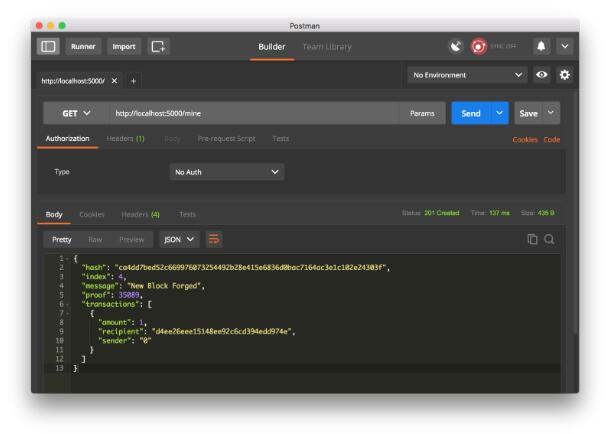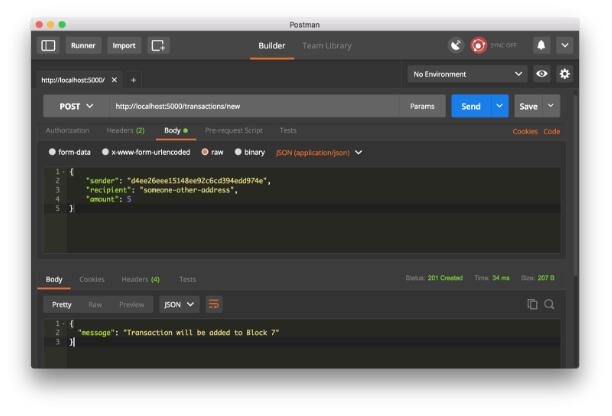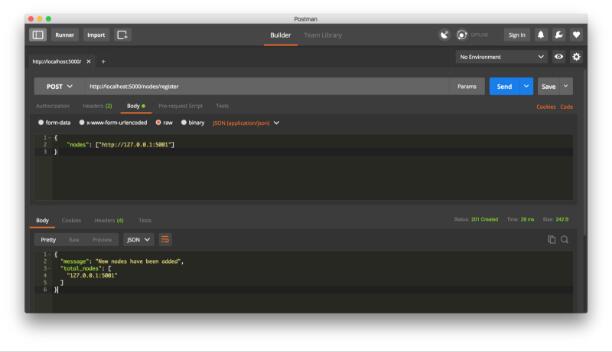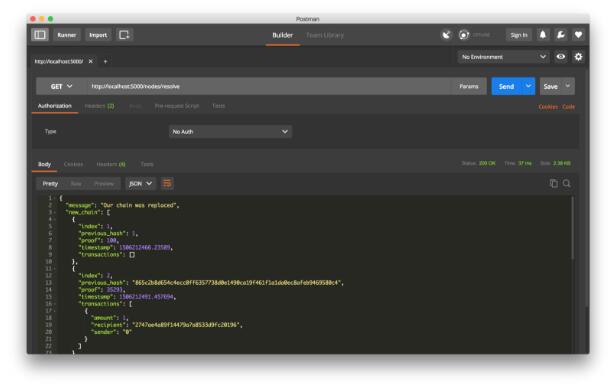作者認為最快的學習區(qū)塊鏈的方式是自己創(chuàng)建一個,本文就跟隨作者用Python來創(chuàng)建一個區(qū)塊鏈。
對數(shù)字貨幣的崛起感到新奇的我們,并且想知道其背后的技術(shù)——區(qū)塊鏈是怎樣實現(xiàn)的。
但是完全搞懂區(qū)塊鏈并非易事,我喜歡在實踐中學習,通過寫代碼來學習技術(shù)會掌握得更牢固。通過構(gòu)建一個區(qū)塊鏈可以加深對區(qū)塊鏈的理解。
準備工作
本文要求讀者對Python有基本的理解,能讀寫基本的Python,并且需要對HTTP請求有基本的了解。
我們知道區(qū)塊鏈是由區(qū)塊的記錄構(gòu)成的不可變、有序的鏈結(jié)構(gòu),記錄可以是交易、文件或任何你想要的數(shù)據(jù),重要的是它們是通過哈希值(hashes)鏈接起來的。
如果你還不是很了解哈希,可以查看這篇文章
環(huán)境準備
環(huán)境準備,確保已經(jīng)安裝Python3.6+, pip , Flask, requests
安裝方法:
|
1
|
pip install Flask==0.12.2 requests==2.18.4 |
同時還需要一個HTTP客戶端,比如Postman,cURL或其它客戶端。
參考源代碼(原代碼在我翻譯的時候,無法運行,我fork了一份,修復了其中的錯誤,并添加了翻譯,感謝star)
開始創(chuàng)建Blockchain
新建一個文件 blockchain.py,本文所有的代碼都寫在這一個文件中,可以隨時參考源代碼
Blockchain類
首先創(chuàng)建一個Blockchain類,在構(gòu)造函數(shù)中創(chuàng)建了兩個列表,一個用于儲存區(qū)塊鏈,一個用于儲存交易。
以下是Blockchain類的框架:
|
1
2
3
4
5
6
7
8
9
10
11
12
13
14
15
16
17
18
19
20
21
22
|
class Blockchain(object): def __init__(self): self.chain = [] self.current_transactions = [] def new_block(self): # Creates a new Block and adds it to the chain pass def new_transaction(self): # Adds a new transaction to the list of transactions pass @staticmethod def hash(block): # Hashes a Block pass @property def last_block(self): # Returns the last Block in the chain pass |
Blockchain類用來管理鏈條,它能存儲交易,加入新塊等,下面我們來進一步完善這些方法。
塊結(jié)構(gòu)
每個區(qū)塊包含屬性:索引(index),Unix時間戳(timestamp),交易列表(transactions),工作量證明(稍后解釋)以及前一個區(qū)塊的Hash值。
以下是一個區(qū)塊的結(jié)構(gòu):
|
1
2
3
4
5
6
7
8
9
10
11
12
13
|
block = { 'index': 1, 'timestamp': 1506057125.900785, 'transactions': [ { 'sender': "8527147fe1f5426f9dd545de4b27ee00", 'recipient': "a77f5cdfa2934df3954a5c7c7da5df1f", 'amount': 5, } ], 'proof': 324984774000, 'previous_hash': "2cf24dba5fb0a30e26e83b2ac5b9e29e1b161e5c1fa7425e73043362938b9824"} |
到這里,區(qū)塊鏈的概念就清楚了,每個新的區(qū)塊都包含上一個區(qū)塊的Hash,這是關(guān)鍵的一點,它保障了區(qū)塊鏈不可變性。如果攻擊者破壞了前面的某個區(qū)塊,那么后面所有區(qū)塊的Hash都會變得不正確。
加入交易
接下來我們需要添加一個交易,來完善下new_transaction方法
|
1
2
3
4
5
6
7
8
9
10
11
12
13
14
15
16
17
18
19
|
class Blockchain(object): ... def new_transaction(self, sender, recipient, amount): """ 生成新交易信息,信息將加入到下一個待挖的區(qū)塊中 :param sender: <str> Address of the Sender :param recipient: <str> Address of the Recipient :param amount: <int> Amount :return: <int> The index of the Block that will hold this transaction """ self.current_transactions.append({ 'sender': sender, 'recipient': recipient, 'amount': amount, }) return self.last_block['index'] + 1 |
方法向列表中添加一個交易記錄,并返回該記錄將被添加到的區(qū)塊(下一個待挖掘的區(qū)塊)的索引,等下在用戶提交交易時會有用。
創(chuàng)建新塊
當Blockchain實例化后,我們需要構(gòu)造一個創(chuàng)世塊(沒有前區(qū)塊的第一個區(qū)塊),并且給它加上一個工作量證明。
每個區(qū)塊都需要經(jīng)過工作量證明,俗稱挖礦,稍后會繼續(xù)講解。
為了構(gòu)造創(chuàng)世塊,我們還需要完善new_block(), new_transaction() 和hash() 方法:
|
1
2
3
4
5
6
7
8
9
10
11
12
13
14
15
16
17
18
19
20
21
22
23
24
25
26
27
28
29
30
31
32
33
34
35
36
37
38
39
40
41
42
43
44
45
46
47
48
49
50
51
52
53
54
55
56
57
58
59
60
61
62
63
64
65
66
|
import hashlibimport jsonfrom time import timeclass Blockchain(object): def __init__(self): self.current_transactions = [] self.chain = [] # Create the genesis block self.new_block(previous_hash=1, proof=100) def new_block(self, proof, previous_hash=None): """ 生成新塊 :param proof: <int> The proof given by the Proof of Work algorithm :param previous_hash: (Optional) <str> Hash of previous Block :return: <dict> New Block """ block = { 'index': len(self.chain) + 1, 'timestamp': time(), 'transactions': self.current_transactions, 'proof': proof, 'previous_hash': previous_hash or self.hash(self.chain[-1]), } # Reset the current list of transactions self.current_transactions = [] self.chain.append(block) return block def new_transaction(self, sender, recipient, amount): """ 生成新交易信息,信息將加入到下一個待挖的區(qū)塊中 :param sender: <str> Address of the Sender :param recipient: <str> Address of the Recipient :param amount: <int> Amount :return: <int> The index of the Block that will hold this transaction """ self.current_transactions.append({ 'sender': sender, 'recipient': recipient, 'amount': amount, }) return self.last_block['index'] + 1 @property def last_block(self): return self.chain[-1] @staticmethod def hash(block): """ 生成塊的 SHA-256 hash值 :param block: <dict> Block :return: <str> """ # We must make sure that the Dictionary is Ordered, or we'll have inconsistent hashes block_string = json.dumps(block, sort_keys=True).encode() return hashlib.sha256(block_string).hexdigest() |
通過上面的代碼和注釋可以對區(qū)塊鏈有直觀的了解,接下來我們看看區(qū)塊是怎么挖出來的。
理解工作量證明
新的區(qū)塊依賴工作量證明算法(PoW)來構(gòu)造。PoW的目標是找出一個符合特定條件的數(shù)字,這個數(shù)字很難計算出來,但容易驗證。這就是工作量證明的核心思想。
為了方便理解,舉個例子:
假設(shè)一個整數(shù) x 乘以另一個整數(shù) y 的積的 Hash 值必須以 0 結(jié)尾,即 hash(x * y) = ac23dc…0。設(shè)變量 x = 5,求 y 的值?
用Python實現(xiàn)如下:
|
1
2
3
4
5
6
|
from hashlib import sha256x = 5y = 0 # y未知while sha256(f'{x*y}'.encode()).hexdigest()[-1] != "0": y += 1print(f'The solution is y = {y}') |
結(jié)果是y=21. 因為:
|
1
|
hash(5 * 21) = 1253e9373e...5e3600155e860 |
在比特幣中,使用稱為Hashcash的工作量證明算法,它和上面的問題很類似。礦工們?yōu)榱藸帄Z創(chuàng)建區(qū)塊的權(quán)利而爭相計算結(jié)果。通常,計算難度與目標字符串需要滿足的特定字符的數(shù)量成正比,礦工算出結(jié)果后,會獲得比特幣獎勵。
當然,在網(wǎng)絡(luò)上非常容易驗證這個結(jié)果。
實現(xiàn)工作量證明
讓我們來實現(xiàn)一個相似PoW算法,規(guī)則是:尋找一個數(shù) p,使得它與前一個區(qū)塊的 proof 拼接成的字符串的 Hash 值以 4 個零開頭。
|
1
2
3
4
5
6
7
8
9
10
11
12
13
14
15
16
17
18
19
20
21
22
23
24
25
26
27
28
29
30
31
32
33
34
35
36
37
|
import hashlibimport jsonfrom time import timefrom uuid import uuid4class Blockchain(object): ... def proof_of_work(self, last_proof): """ 簡單的工作量證明: - 查找一個 p' 使得 hash(pp') 以4個0開頭 - p 是上一個塊的證明, p' 是當前的證明 :param last_proof: <int> :return: <int> """ proof = 0 while self.valid_proof(last_proof, proof) is False: proof += 1 return proof @staticmethod def valid_proof(last_proof, proof): """ 驗證證明: 是否hash(last_proof, proof)以4個0開頭? :param last_proof: <int> Previous Proof :param proof: <int> Current Proof :return: <bool> True if correct, False if not. """ guess = f'{last_proof}{proof}'.encode() guess_hash = hashlib.sha256(guess).hexdigest() return guess_hash[:4] == "0000" |
衡量算法復雜度的辦法是修改零開頭的個數(shù)。使用4個來用于演示,你會發(fā)現(xiàn)多一個零都會大大增加計算出結(jié)果所需的時間。
現(xiàn)在Blockchain類基本已經(jīng)完成了,接下來使用HTTP requests來進行交互。
Blockchain作為API接口
我們將使用Python Flask框架,這是一個輕量Web應(yīng)用框架,它方便將網(wǎng)絡(luò)請求映射到 Python函數(shù),現(xiàn)在我們來讓Blockchain運行在基于Flask web上。
我們將創(chuàng)建三個接口:
/transactions/new 創(chuàng)建一個交易并添加到區(qū)塊
/mine 告訴服務(wù)器去挖掘新的區(qū)塊
/chain 返回整個區(qū)塊鏈
創(chuàng)建節(jié)點
我們的“Flask服務(wù)器”將扮演區(qū)塊鏈網(wǎng)絡(luò)中的一個節(jié)點。我們先添加一些框架代碼:
|
1
2
3
4
5
6
7
8
9
10
11
12
13
14
15
16
17
18
19
20
21
22
23
24
25
26
27
28
29
30
31
32
33
34
35
36
37
38
39
40
41
|
import hashlibimport jsonfrom textwrap import dedentfrom time import timefrom uuid import uuid4from flask import Flaskclass Blockchain(object): ...# Instantiate our Nodeapp = Flask(__name__)# Generate a globally unique address for this nodenode_identifier = str(uuid4()).replace('-', '')# Instantiate the Blockchainblockchain = Blockchain()@app.route('/mine', methods=['GET'])def mine(): return "We'll mine a new Block" @app.route('/transactions/new', methods=['POST'])def new_transaction(): return "We'll add a new transaction"@app.route('/chain', methods=['GET'])def full_chain(): response = { 'chain': blockchain.chain, 'length': len(blockchain.chain), } return jsonify(response), 200if __name__ == '__main__': app.run(host='0.0.0.0', port=5000) |
簡單的說明一下以上代碼:
第15行: 創(chuàng)建一個節(jié)點.
第18行: 為節(jié)點創(chuàng)建一個隨機的名字.
第21行: 實例Blockchain類.
第24–26行: 創(chuàng)建/mine GET接口。
第28–30行: 創(chuàng)建/transactions/new POST接口,可以給接口發(fā)送交易數(shù)據(jù).
第32–38行: 創(chuàng)建 /chain 接口, 返回整個區(qū)塊鏈。
第40–41行: 服務(wù)運行在端口5000上.
發(fā)送交易
發(fā)送到節(jié)點的交易數(shù)據(jù)結(jié)構(gòu)如下:
|
1
2
3
4
5
|
{ "sender": "my address", "recipient": "someone else's address", "amount": 5} |
之前已經(jīng)有添加交易的方法,基于接口來添加交易就很簡單了
|
1
2
3
4
5
6
7
8
9
10
11
12
13
14
15
16
17
18
19
20
21
22
23
24
|
import hashlibimport jsonfrom textwrap import dedentfrom time import timefrom uuid import uuid4from flask import Flask, jsonify, request...@app.route('/transactions/new', methods=['POST'])def new_transaction(): values = request.get_json() # Check that the required fields are in the POST'ed data required = ['sender', 'recipient', 'amount'] if not all(k in values for k in required): return 'Missing values', 400 # Create a new Transaction index = blockchain.new_transaction(values['sender'], values['recipient'], values['amount']) response = {'message': f'Transaction will be added to Block {index}'} return jsonify(response), 201 |
挖礦
挖礦正是神奇所在,它很簡單,做了一下三件事:
- 計算工作量證明PoW
- 通過新增一個交易授予礦工(自己)一個幣
- 構(gòu)造新區(qū)塊并將其添加到鏈中
|
1
2
3
4
5
6
7
8
9
10
11
12
13
14
15
16
17
18
19
20
21
22
23
24
25
26
27
28
29
30
31
32
33
34
35
36
|
import hashlibimport jsonfrom time import timefrom uuid import uuid4from flask import Flask, jsonify, request...@app.route('/mine', methods=['GET'])def mine(): # We run the proof of work algorithm to get the next proof... last_block = blockchain.last_block last_proof = last_block['proof'] proof = blockchain.proof_of_work(last_proof) # 給工作量證明的節(jié)點提供獎勵. # 發(fā)送者為 "0" 表明是新挖出的幣 blockchain.new_transaction( sender="0", recipient=node_identifier, amount=1, ) # Forge the new Block by adding it to the chain block = blockchain.new_block(proof) response = { 'message': "New Block Forged", 'index': block['index'], 'transactions': block['transactions'], 'proof': block['proof'], 'previous_hash': block['previous_hash'], } return jsonify(response), 200 |
注意交易的接收者是我們自己的服務(wù)器節(jié)點,我們做的大部分工作都只是圍繞Blockchain類方法進行交互。到此,我們的區(qū)塊鏈就算完成了,我們來實際運行下
運行區(qū)塊鏈
你可以使用cURL 或Postman 去和API進行交互
啟動server:
|
1
2
|
$ python blockchain.py* Runing on http://127.0.0.1:5000/ (Press CTRL+C to quit) |
讓我們通過請求 http://localhost:5000/mine 來進行挖礦

通過post請求,添加一個新交易

如果不是使用Postman,則用一下的cURL語句也是一樣的:
|
1
2
3
4
5
|
$ curl -X POST -H "Content-Type: application/json" -d '{ "sender": "d4ee26eee15148ee92c6cd394edd974e", "recipient": "someone-other-address", "amount": 5}' "http://localhost:5000/transactions/new" |
在挖了兩次礦之后,就有3個塊了,通過請求 http://localhost:5000/chain 可以得到所有的塊信息。
|
1
2
3
4
5
6
7
8
9
10
11
12
13
14
15
16
17
18
19
20
21
22
23
24
25
26
27
28
29
30
31
32
33
34
35
36
37
38
|
{ "chain": [ { "index": 1, "previous_hash": 1, "proof": 100, "timestamp": 1506280650.770839, "transactions": [] }, { "index": 2, "previous_hash": "c099bc...bfb7", "proof": 35293, "timestamp": 1506280664.717925, "transactions": [ { "amount": 1, "recipient": "8bbcb347e0634905b0cac7955bae152b", "sender": "0" } ] }, { "index": 3, "previous_hash": "eff91a...10f2", "proof": 35089, "timestamp": 1506280666.1086972, "transactions": [ { "amount": 1, "recipient": "8bbcb347e0634905b0cac7955bae152b", "sender": "0" } ] } ], "length": 3} |
一致性(共識)
我們已經(jīng)有了一個基本的區(qū)塊鏈可以接受交易和挖礦。但是區(qū)塊鏈系統(tǒng)應(yīng)該是分布式的。既然是分布式的,那么我們究竟拿什么保證所有節(jié)點有同樣的鏈呢?這就是一致性問題,我們要想在網(wǎng)絡(luò)上有多個節(jié)點,就必須實現(xiàn)一個一致性的算法。
注冊節(jié)點
在實現(xiàn)一致性算法之前,我們需要找到一種方式讓一個節(jié)點知道它相鄰的節(jié)點。每個節(jié)點都需要保存一份包含網(wǎng)絡(luò)中其它節(jié)點的記錄。因此讓我們新增幾個接口:
/nodes/register 接收URL形式的新節(jié)點列表
/nodes/resolve 執(zhí)行一致性算法,解決任何沖突,確保節(jié)點擁有正確的鏈
我們修改下Blockchain的init函數(shù)并提供一個注冊節(jié)點方法:
|
1
2
3
4
5
6
7
8
9
10
11
12
13
14
15
16
17
18
19
20
|
...from urllib.parse import urlparse...class Blockchain(object): def __init__(self): ... self.nodes = set() ... def register_node(self, address): """ Add a new node to the list of nodes :param address: <str> Address of node. Eg. 'http://192.168.0.5:5000' :return: None """ parsed_url = urlparse(address) self.nodes.add(parsed_url.netloc) |
我們用 set 來儲存節(jié)點,這是一種避免重復添加節(jié)點的簡單方法。
實現(xiàn)共識算法
前面提到,沖突是指不同的節(jié)點擁有不同的鏈,為了解決這個問題,規(guī)定最長的、有效的鏈才是最終的鏈,換句話說,網(wǎng)絡(luò)中有效最長鏈才是實際的鏈。
我們使用一下的算法,來達到網(wǎng)絡(luò)中的共識
|
1
2
3
4
5
6
7
8
9
10
11
12
13
14
15
16
17
18
19
20
21
22
23
24
25
26
27
28
29
30
31
32
33
34
35
36
37
38
39
40
41
42
43
44
45
46
47
48
49
50
51
52
53
54
55
56
57
58
59
60
61
62
63
64
65
66
67
|
...import requestsclass Blockchain(object) ... def valid_chain(self, chain): """ Determine if a given blockchain is valid :param chain: <list> A blockchain :return: <bool> True if valid, False if not """ last_block = chain[0] current_index = 1 while current_index < len(chain): block = chain[current_index] print(f'{last_block}') print(f'{block}') print("\n-----------\n") # Check that the hash of the block is correct if block['previous_hash'] != self.hash(last_block): return False # Check that the Proof of Work is correct if not self.valid_proof(last_block['proof'], block['proof']): return False last_block = block current_index += 1 return True def resolve_conflicts(self): """ 共識算法解決沖突 使用網(wǎng)絡(luò)中最長的鏈. :return: <bool> True 如果鏈被取代, 否則為False """ neighbours = self.nodes new_chain = None # We're only looking for chains longer than ours max_length = len(self.chain) # Grab and verify the chains from all the nodes in our network for node in neighbours: response = requests.get(f'http://{node}/chain') if response.status_code == 200: length = response.json()['length'] chain = response.json()['chain'] # Check if the length is longer and the chain is valid if length > max_length and self.valid_chain(chain): max_length = length new_chain = chain # Replace our chain if we discovered a new, valid chain longer than ours if new_chain: self.chain = new_chain return True return False |
第一個方法 valid_chain() 用來檢查是否是有效鏈,遍歷每個塊驗證hash和proof.
第2個方法 resolve_conflicts() 用來解決沖突,遍歷所有的鄰居節(jié)點,并用上一個方法檢查鏈的有效性, 如果發(fā)現(xiàn)有效更長鏈,就替換掉自己的鏈
讓我們添加兩個路由,一個用來注冊節(jié)點,一個用來解決沖突。
|
1
2
3
4
5
6
7
8
9
10
11
12
13
14
15
16
17
18
19
20
21
22
23
24
25
26
27
28
29
30
31
32
33
34
|
@app.route('/nodes/register', methods=['POST'])def register_nodes(): values = request.get_json() nodes = values.get('nodes') if nodes is None: return "Error: Please supply a valid list of nodes", 400 for node in nodes: blockchain.register_node(node) response = { 'message': 'New nodes have been added', 'total_nodes': list(blockchain.nodes), } return jsonify(response), 201@app.route('/nodes/resolve', methods=['GET'])def consensus(): replaced = blockchain.resolve_conflicts() if replaced: response = { 'message': 'Our chain was replaced', 'new_chain': blockchain.chain } else: response = { 'message': 'Our chain is authoritative', 'chain': blockchain.chain } return jsonify(response), 200 |
你可以在不同的機器運行節(jié)點,或在一臺機機開啟不同的網(wǎng)絡(luò)端口來模擬多節(jié)點的網(wǎng)絡(luò),這里在同一臺機器開啟不同的端口演示,在不同的終端運行一下命令,就啟動了兩個節(jié)點:http://localhost:5000 和 http://localhost:5001
|
1
2
|
pipenv run python blockchain.pypipenv run python blockchain.py -p 5001 |

然后在節(jié)點2上挖兩個塊,確保是更長的鏈,然后在節(jié)點1上訪問接口/nodes/resolve ,這時節(jié)點1的鏈會通過共識算法被節(jié)點2的鏈取代。

好啦,你可以邀請朋友們一起來測試你的區(qū)塊鏈
本文主要內(nèi)容翻譯自Learn Blockchains by Building One
原文鏈接:https://learnblockchain.cn/2017/10/27/build_blockchain_by_python/










